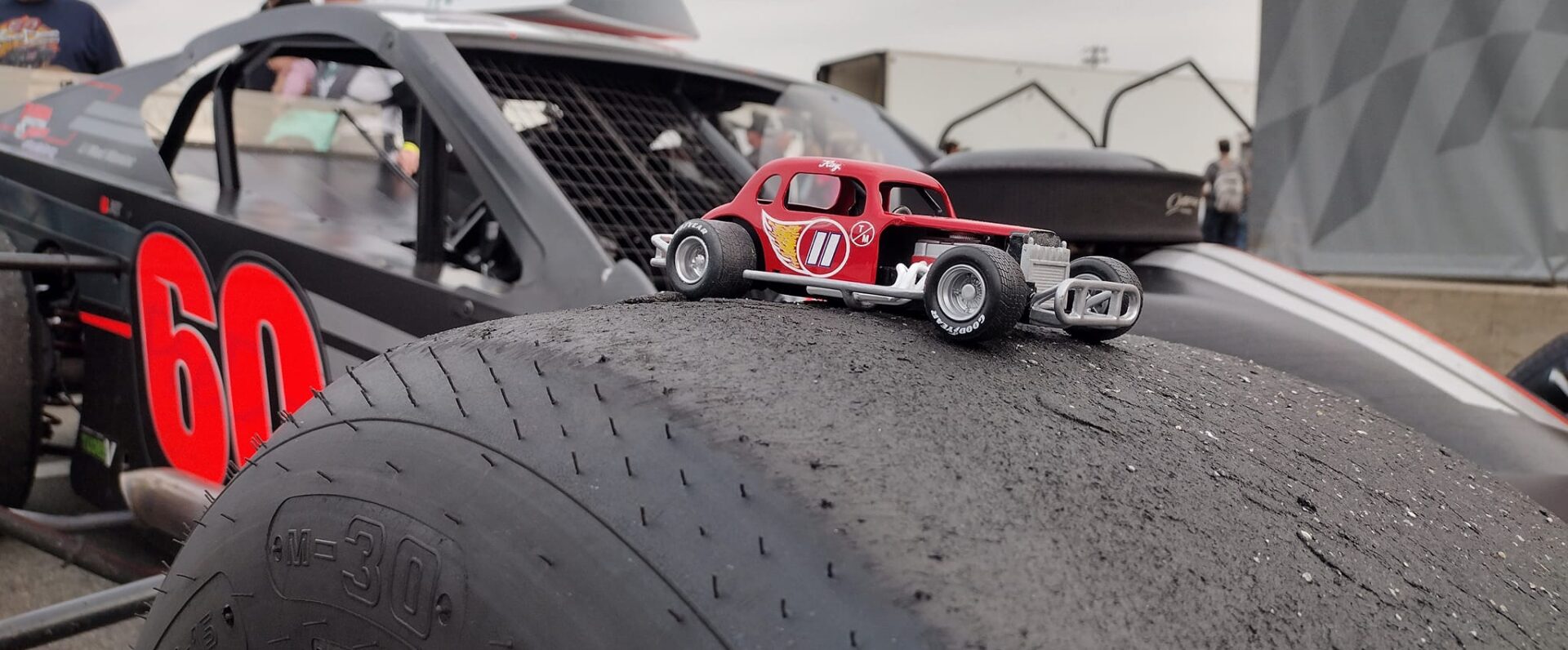
As we’ve said from the beginning, in order for stock car racing to step boldly into the new era it now finds itself fully immersed in, it must first and foremost remember where it’s foundation truly lies. And although some say that the powers that be at the top of the stock car world have at times forgotten this as they move forward, that cannot be said about the true core of the sport on the local level. The ultimate proof of that lies at the heart of the division that NASCAR built it’s future off of from the beginning.
The truth of it all as many are well aware of is that stock car racing had it’s roots in the southern clay even if the bigger dreams for it’s future were hatched in the sands of southern Florida. Those dreams were spurred by a group of racers who were already racing their modified cars on the dirt out in fields throughout the south. Cars built for speed in the era of prohibition, proven in the back roads under the light of the moon where speed was an absolute must. Soon it became a question of who had the fastest car, and with that question, who was the best driver? Those answers came in the fields that became America’s first stock car tracks. Many of those tracks still remain here in the central east coast region after being covered with asphalt in the heyday of NASCAR’s glorious rise. And they remain despite the organization of NASCAR’s move to superspeedways. While NASCAR fulfilled it’s dreams of massive asphalt tracks, it still pulled it’s on track sources from where it always did, the short tracks of the south.
Short track racing through the years spread all across the country. In many ways it’s become it’s own subculture in the sport of stock car auto racing. Although many racers’ goal is still to make it to the “big leagues” of NASCAR’s premier series, there are also just as many who are satisfied running their local short tracks for their entire career. There’s also the growing phenomenon of fans who only go to ‘”big time” NASCAR racing, countered by those fans who would rather go see the stars run at their local short track. There’s a whole bevy of reasoning behind this growing trend that we are bound to touch on in the very near future even though some in the industry want to shy away from it all together, but it’s only mentioned here to point out that short track racing has always had it’s battles for relevance. Battles that arose from the very beginnings of organizational stock car racing.

NASCAR’s first sanctioned race was a Modified event at Daytona Beach on February 15, 1948. But just a little over a year later in June 1949, NASCAR changed it’s premier series to what was then called Strictly Stock. Later it became known as the Grand National Division and eventually evolved into the NASCAR Cup Series. The organization stated the reasons for the change was because they wanted the cars competing in their top series to be current and represent the cars that you could buy at your local dealerships. And in fact those cars were factory cars only modified for safety. But in total truth, the change came from pressure from the auto manufacturers who’s main interest in the sport was to primarily sell cars. And what better way to sell them than to showcase them competing at the track, highlighting their speed and performance. An ingenious promotional plan that was highly successful for both manufacturers and for NASCAR itself.
Meanwhile, in 1949, Modifieds were regulated to weekly racing in Winston-Salem, North Carolina at the famed quarter mile dubbed “The Madhouse”, Bowman Gray Stadium. It is currently the oldest running weekly racing track in the country who’s top division is still the Modifieds who’ve kept it the highest attended local short track in the nation. Tim Flock won the 1949 championship before going on to win the Grand National championship in 1952 and 1955. In 1951, Billy Myers won his first Modified Championship at the Stadium with his brother Bobby winning it the very next year. That would be Bobby’s one and only Modified championship at the Stadium while Billy went on to win two more in 1953 and 1955. While dynasties were built and local superstars were made, it took on a whole new life in the northeast where it grew and began to thrive.
NASCAR has kept it’s hands in the Modified game however as Bowman Gray Stadium still holds it’s NASCAR sanction, and in the Northeast, the biggest Modified touring series is the NASCAR sanctioned Whelen Modified Tour. But, times have changed. The Whelen Modified Tour once had 2 divisions, North and South, but truthfully the southern touring division was never as strong as it became in the northeast, and eventually, NASCAR dropped the southern division altogether, once again leaving the Modifieds solely in the hands of the stadium. If the tour was going to be revived again, those who were going to achieve it were going to have to go back to the heart of those beginning racers who started stock car racing to begin with. The mind of the independent has to start any endeavor truly from the love of what they are about to do first and foremost if he wants that endeavor to survive what comes against it. But as Late Model Stocks took center stage in the south, those who’s heart were still in Modified racing never lost their love for it. And in 2020, the SMART Modified Tour was reborn. Running their first full season in 2021, they relied on the names that kept Modified racing alive in the south, so it was no surprise to see ten time Bowman Gray Modified Champion Burt Myers as the first title winner of the revamped tour. It didn’t hurt to have NASCAR Hall Of Famer Bobby Labonte in the ranks as a competitor along with visiting stars from the northeast as well. Those facts alone were true indicators of the support for the endeavor.
But we said from the very beginning that if the newly revamped SMART Modified Tour was going to not only succeed today but thrive into the future, it was going to have to adapt at least somewhat the model of stability the Modified teams in the northeast had learned and built upon. It’s a model that ensures that the future stars of the tour are prepared for top level touring racing in a way that’s successful. Yes, Bowman Gray Stadium is a place that grows tough racers, but it’s expensive and unrelenting on young talent. It’s a place that will chew you up and spit you out if you let it. We’ve been full witness to that. But up north, they grow talent in 602 Modifieds, just like Late Model Stocks grow their ranks in Limiteds, Challengers, and Chargers in the south. As in any sport, the youth are your future, and they have to gain their experience in a way that builds confidence without breaking their backs in the process. And somewhere over the past few years, the guys that make the decisions on the SMART Tour have come to understand that. It’s a decision they had to come to for the future of the tour. It’s an important one as Crate Modified racing, although tried here from time to time, has never really taken hold. But then again, no one we’ve seen has been more determined to change that than the Carolina Crate Modified Series.



Last year the Carolina Crate Modified Series held Crate Modifieds’ biggest race ever in the central east coast short track region at North Wilkesboro Speedway. Over 40 drivers entered but only 36 had the pleasure of taking the green flag. It was a big moment not only for Crate Modified racing in the region but Modified racing in general in the south. Crate Modified racing is where the 2024 SMART Tour season opening winner Carson Loftin got his first Modified win, and where Slate Myers captured his first pole. And that’s important as these drivers are both 15 and will very likely be factors in the future of southern Touring Modified racing. Fitting as Carson is a third generation Modified driver while Slate is one of the first fourth generation Modified drivers in the country. Carson’s grandfather Bobby competed on the original SMART Modified Tour with his father Brian tying for the most wins on the season in the original tour’s last season in 2004 with four wins that year. Slate has even bigger shoes to fill with his grandfather Gary winning a SMART championship in 1996 and father Burt winning one original SMART Championship in 2002, and now following that up with two on the revamped tour in the first full season in 2021, and last year in 2023. And although Slate has yet to run a race on the tour, he’s already preparing to run select Crate races in the region as well as continuing to get his feet wet at Bowman Gray Stadium where his family has raced Modifieds from the very beginning.
Although the Carolina Crate Modifieds have run events with the SMART Modified Tour over the past couple of seasons, this will be the first year they run a significant number of events supporting the south’s premier Touring Modified Series. It’s a smart move from both organizations that if continued could be extremely huge for Touring Modifieds going forward. With that, the SMART Tour will have a roster of southern veterans who have persevered in the sport mostly nestled on Saturday nights in Winston-Salem out of their love for Modified cars themselves and their immense history, joined by some of the best visiting northeastern talent who are fully aware of the Modified history and share the same love for Modified racing, while also being accompanied by up and coming youthful talent who are determined to write the next chapter of southern Modified racing. Those combinations with the vision of Chris Williams and Jeff Bunton on the SMART Tour along with the determination of the Graham family on the Carolina Crate Modified Series lead us to be as optimistic as we’ve ever been as southern Modified racing steps into the new era of short track racing in the region. And as a nod to that understanding, the south’s premier Touring Modified series will add the newest Modified Crown Jewel event this year at South Boston Speedway on March 23 dubbed The King Of The Modifieds that will pay $20,000 to the winner. It comes as an absolute benefit of the re-signing of a title sponsorship deal with Pace-O-Matic, this time for multiple years that the tour can build on into the future. Yes! Stock car racing’s oldest division is heating back up in the south as 2024 looks to be one of if not the biggest year in southern Touring Modified’s history. And as we are entered into a new era of short track racing, it could be a year that goes a long way of taking it far into the future.




Leave a Reply